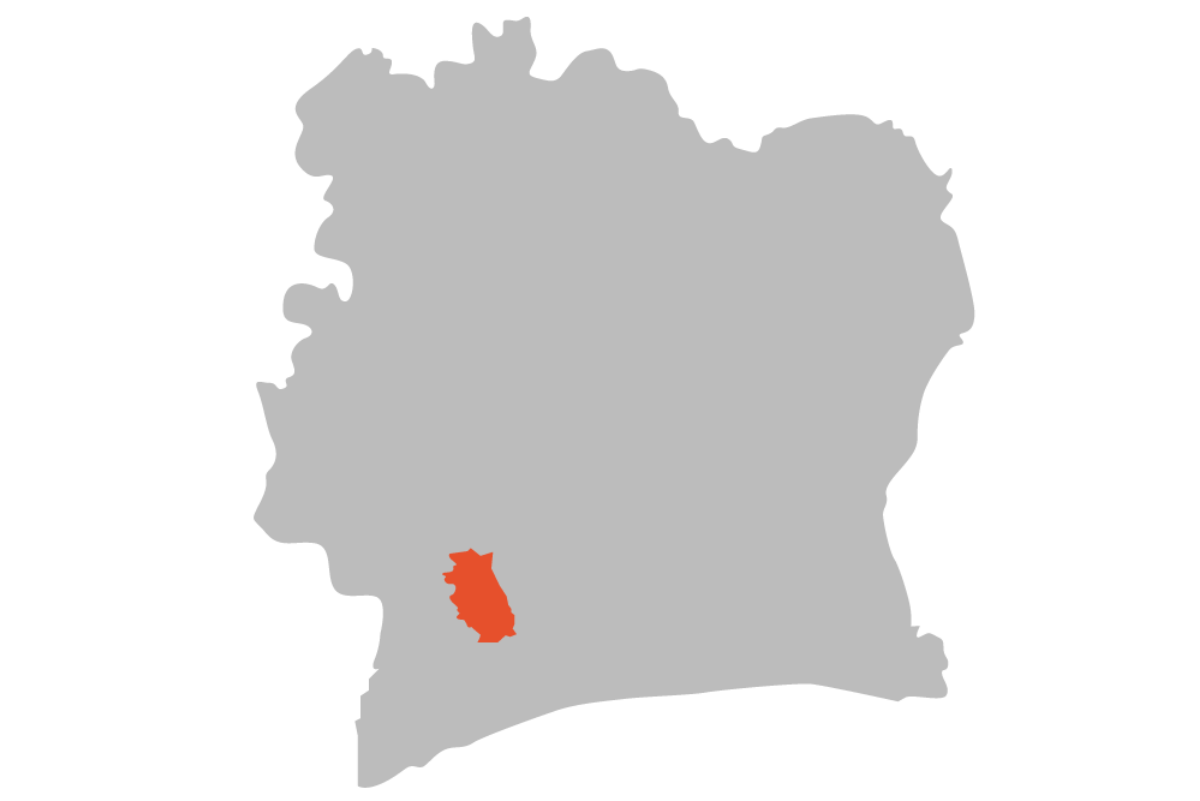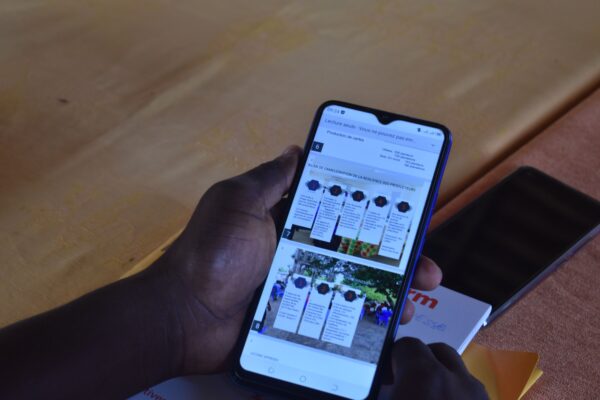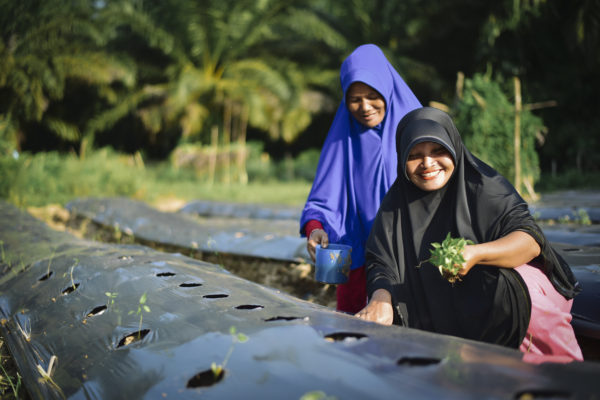This case study is part of Earthworm Foundation's awareness campaign on forests. Visit the campaign page and search #ForTheForests across social media platforms to learn more about the campaign.
Since 2014, Earthworm has worked in the western region of Soubré, Ivory Coast with small-scale cocoa and oil palm farmers. The aim is to build their resilience by coaching them on good agricultural practices and how to diversify their income.
Soubré is the largest cocoa-producing area in the Ivory Coast, accounting for 20 percent of national production. The region is also full of protected areas threatened by agriculture.
"We have the Taï National Park in the west, the forest reserves of Niégré in the south-east, Grah Rapids in the south-west and Monts Kourabahi in the north. These forests are heavily infiltrated by cocoa farmers," explains Eléonore N'Gbesso Tanoh, who leads our work with farmers in the Ivory Coast.
The Taï National Park is the best-preserved forest in the country. However, forest reserves in Niegre and Monts Kourabahi have lost more than 80 percent of forest cover. Some have secretly started cocoa farms inside those forests and a substantial community lives off income from these farms.
This complex situation, coupled with national deforestation rates, led the Ivorian government to adopt a new forestry code in 2019. The country has one of the highest deforestation rates in Africa, losing around 80 percent of its forest from 1960 to 2015. A 2017 Mighty Earth report argues 90 percent of protected areas have turned into cocoa crops.
The 2019 Ivorian forestry code distinguishes forests in three categories. The first forbids human activities and presence, an example being the Cavally Forest Reserve. The second category allows agroforestry for a limited time, like in Niégré; while the third is permanently classified for agroforestry, of which Monts Kourabahi is an example. Agroforestry is the incorporation of trees in plantations.
“It is a way to maximise land by combining trees with crops or livestock, and restores the ecological balance of agricultural land. Agroforestry also improves the stability of soils and local weather conditions,” Eléonore said.
With financial support from Godiva, Earthworm is encouraging communities to take up agroforestry. This is done by explaining its importance and helping establish tree nurseries. Saplings from the nursery will then be introduced in inside and outside Niégré and Monts Kourabahi forest reserves.
To convince as many farmers as possible, we work with the Ivory Coast forest management agency, SODEFOR (Société de Développement des Forêts de Côte d'Ivoire). SODEFOR helps with access to forest reserves, as well as the identification and reforestation of degraded areas.
“Awareness campaigns are conducted with SODEFOR. These campaigns aim to show the importance of protecting the forest and get producers inside and outside the forests to accept and take ownership of the idea," explained Eléonore.
About 190 farmers have participated so far. Two village committees have also been set up to protect the Niegre and Monts Kourabahi forests reserves. With the communities, sites have been chosen and prepared for the installation of about 15,000 native tree nurseries. We wish to recover two to five percent of the forest cover of Niégré and Mont Kourabahi by 2025.
About 190 farmers have participated so far, and two village committees were set up to protect forests in Niégré and Mont Kourabahi. Planting sites have been prepared for about 15,000 native tree saplings.
About 23 hectares of degraded land in Mont Kourabahi Forest Reserve have been rehabilitated with 1,597 trees planted. Species planted include Ilomba, Niangon, Koto, Bois Bété, Framiré, Makoré and Cedrella trees. The trees are being maintained to ensure an 80 percent survival rate. A youth group has also cut grass on the planting line to strengthen tree saplings.

"We wish to recover two to five percent of the forest cover in Niégré and Mont Kourabahi by 2025," said Eléonore N'Gbesso Tanoh, Earthworm's project lead in the Ivory Coast.
Soubré is the largest cocoa-producing area in the Ivory Coast, accounting for 20 percent of national production. The region is also home to protected areas threatened by agriculture. These include the Taï National Park, as well as forests in Niégré, Grah Rapids and Monts Kourabahi.
The region is also home to protected areas threatened by agriculture. These include the Taï National Park, as well as forests in Niégré, Grah Rapids and Monts Kourabahi. While Taï National Park is the best-preserved forest in the country, Niegre and Monts Kourabahi have lost more than 80 percent of their forest cover.
Accounting for 20 percent of national production, Soubré is the largest cocoa-producing area in Côte d'Ivoire - the largest cocoa-grower in the world.

This complex situation, coupled with national deforestation rates, led the Ivorian government to adopt a new forestry code in 2019. The country has one of the highest deforestation rates in Africa, losing around 80 percent of its forest from 1960 to 2015. A 2017 Mighty Earth report argues 90 percent of protected areas have turned into cocoa crops.
The 2019 Ivorian forestry code distinguishes forests in three categories. The first forbids human activities and presence, an example being the Cavally Forest Reserve. The second category allows agroforestry for a limited time, like in Niégré; while the third is permanently classified for agroforestry, of which Monts Kourabahi is an example.
Agroforestry maximises land by combining trees with farm crops or livestock, Eléonore explained. It also restores the ecological balance of land, improving the stability of soils and weather.

The country has one of the highest deforestation rates in Africa, losing around 80 percent of its forest from 1960 to 2015.
With financial support from Godiva, Earthworm is encouraging communities to take up agroforestry, subset of regenerative agriculture. This is done by training farmers and helping them establish tree nurseries. Saplings from the nursery will then be introduced in inside and outside Niégré and Monts Kourabahi forests.
Key to this work is the partnership with the Ivory Coast forest management agency, SODEFOR (Société de Développement des Forêts de Côte d'Ivoire). SODEFOR helps with access to forest reserves, as well as the identification and reforestation of degraded areas.
“With SODEFOR, we aim to show farmers the importance of forests and get them to take ownership of the idea," explained Eléonore.


